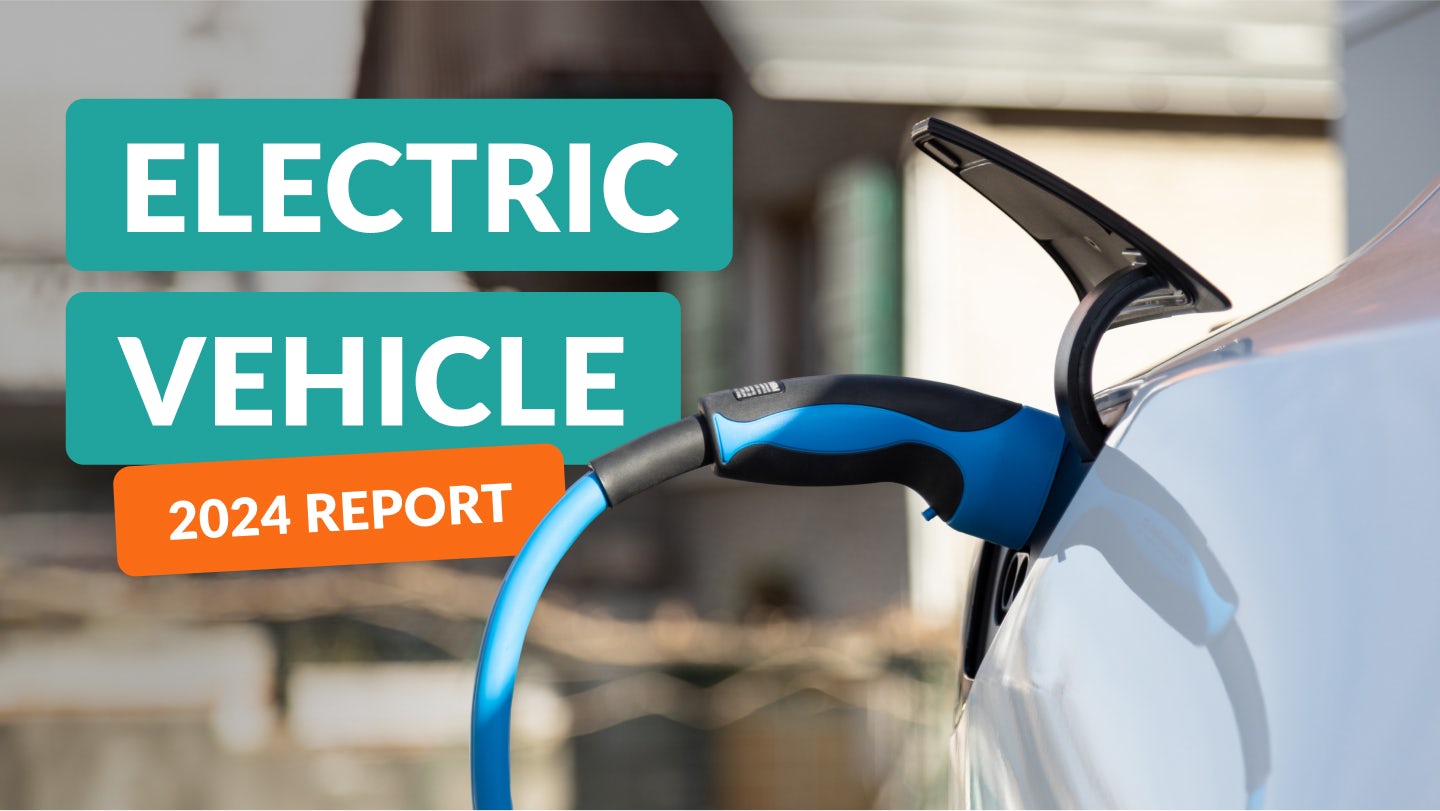
The 2025 EV Charging Station Report: State-by-State Breakdown
With the global focus on expanding the electric vehicle (EV) market and the impending ban on diesel and gasoline vehicle sales in the U.S. by 2035, the prospect of owning an electric vehicle is becoming a reality for many drivers. However, as the U.S. is a vast country with each state operating under its own rules and regulations, the readiness for widespread EV adoption varies significantly. To assess the current state of EV infrastructure, we present the updated 2024 U.S. Electric Vehicle Charging Station Report, offering a comprehensive state-by-state breakdown.
In this report, we explore key questions: How does the rapid growth in EV adoption compare to the development of charging infrastructure? By analyzing the latest data, we aim to provide insights into the feasibility of building a robust EV charging network while evaluating the current EV adoption rates compared to conventional vehicles. Additionally, we examine the major changes since the previous edition, shedding light on the evolving landscape of EVs and charging stations across the U.S.
- The number of EVs in the U.S. has increased by 114%, growing from 1.45 million to over 3.1 million between 2023 and 2024.
- However, the growth in public charging outlets hasn’t quite kept pace, rising by 25%, from 143,771 to 180,000over the same period.
States with the most charging stations per EVs
When you’re considering switching to an electric vehicle you need to consider the competition for charging points. It’s all well and good to go green and try and cut your emissions, but if you can’t charge your vehicle, you aren’t going to get very far. Here are the states with the most chargers per 100 electric vehicles.
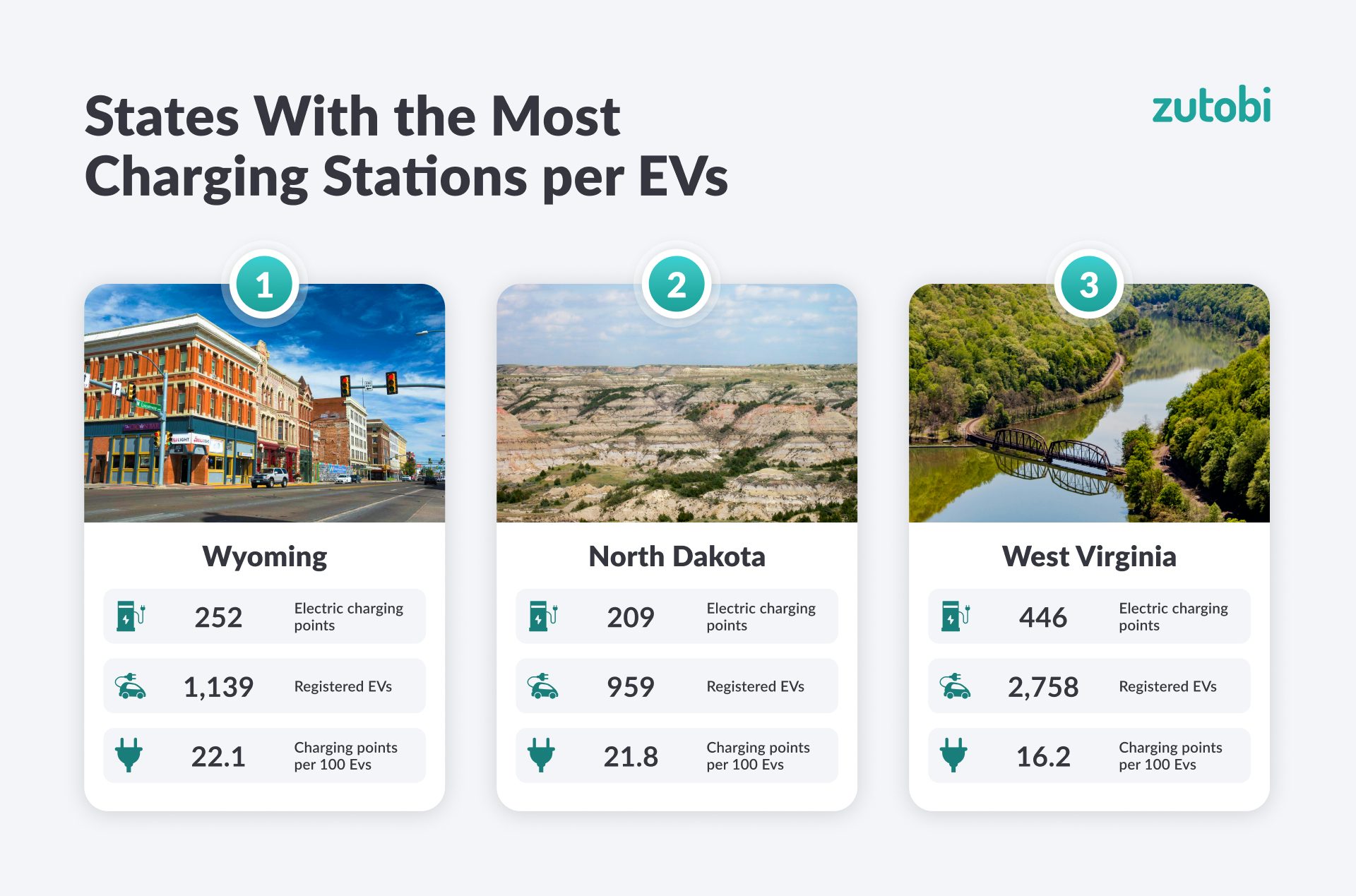
Place 1 – Wyoming
Total electric charging ports: 252
Registered EVs: 1,139
Charging stations per 100 EVs: 22.1
Wyoming leads the nation in terms of charging stations per EV, with 22.12 chargers for every 100 electric vehicles. Despite having only 1,139 registered EVs, Wyoming boasts 252 charging points across the state. This impressive ratio is a reflection of state policies encouraging EV adoption by focusing on infrastructure development first. Wyoming has received federal funds to ensure that charging stations are placed strategically along major highways, ensuring that even in rural areas, EV drivers have access to charging options. However, the low EV adoption rate suggests that more efforts are needed to attract residents to switch to electric.
Place 2 – North Dakota
Total electric charging ports: 209
Registered EVs: 959
Charging stations per 100 EVs: 21.8
North Dakota has also prioritized infrastructure over adoption, offering 21.79 charging stations per 100 EVs, despite having only 959 registered electric vehicles. The state operates 209 charging stations, which serve its small but growing population of EV owners. Like Wyoming, North Dakota’s low number of EVs means that current drivers enjoy easy access to chargers. However, as adoption grows, the state will need to continue expanding its charging network to maintain this favorable ratio.
Place 3 – West Virginia
Total electric charging ports: 446
Registered EVs: 2,758
Charging stations per 100 EVs: 16.2
West Virginia’s focus on expanding its charging infrastructure has resulted in 16.17 charging points per 100 EVs, with 446 chargers for 2,758 registered electric vehicles. The state is investing in charging stations as part of its efforts to reduce emissions and encourage EV ownership. West Virginia’s mountainous terrain makes widespread charger placement challenging, but the state’s progress thus far indicates a commitment to preparing for future EV growth.
States with the fewest charging stations per EVs
Nevertheless, several states are facing challenges in keeping pace with the rapidly growing demand for electric vehicles, particularly in terms of charging infrastructure.
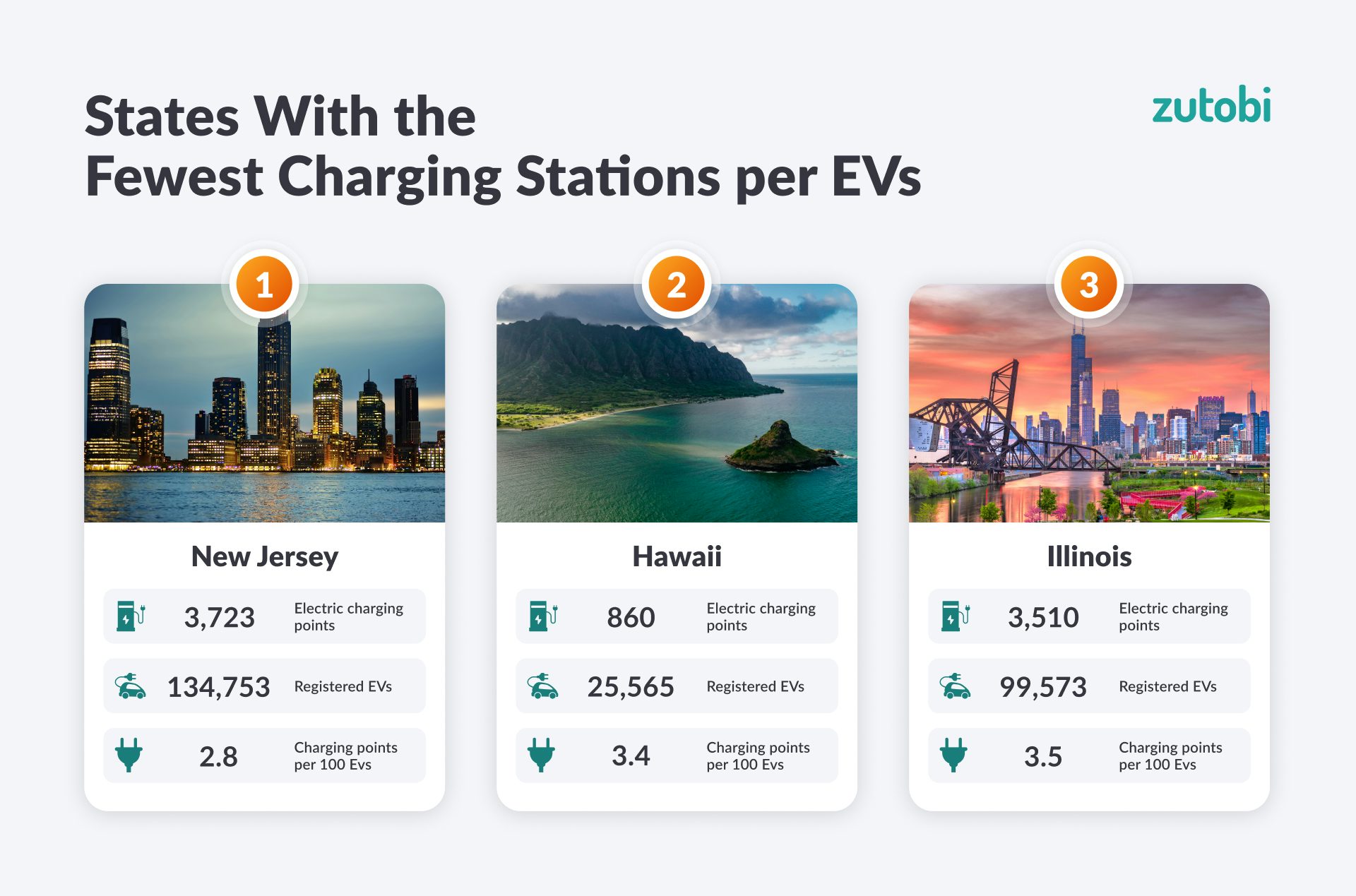
Place 1 – New Jersey
Total electric charging points: 3,723
Registered EVs: 134,753
Charging stations per 100 EVs: 2.76
New Jersey has made remarkable progress in expanding its EV infrastructure, but it still lags behind in terms of charging stations per EV, with only 2.76 chargers for every 100 electric vehicles. The state boasts a high number of registered EVs, with 134,753 on the road, but only 3,723 charging stations are available to serve them. The local government has introduced various initiatives, such as grants to offset the cost of installing EV chargers, which has led to a 33.37% increase in charging stations compared to the previous year. However, with such a high number of EVs, more effort is needed to keep up with demand.
Place 2 – Hawaii
Total electric charging points: 860
Registered EVs: 25,565
Charging stations per 100 EVs: 3.36
Hawaii has 860 charging points for its 25,565 registered EVs, resulting in 3.36 chargers per 100 vehicles. While the state has seen steady growth in EV ownership, its isolated geography and limited land area make expanding charging infrastructure a challenge. That said, the state government continues to push for clean energy solutions, with policies in place to promote the installation of more chargers to meet future demand.
Place 3 – Illinois
Total electric charging points: 3,510
Registered EVs: 99,573
Charging stations per 100 EVs: 3.52
Illinois has 3.52 charging stations per 100 EVs, with 3,510 chargers available for nearly 100,000 registered electric vehicles. Although Illinois has experienced a 35% increase in charging infrastructure over the past year, the state will need to continue investing in public and private charging networks to meet the growing demand from its rapidly expanding EV population.
How many EV charging stations are there in the US? State-by-state breakdown
| № | States | Electric charging points | Registered EVs | Charging points per 100 Evs |
|---|---|---|---|---|
| 1 | Wyoming | 252 | 1,139 | 22.1 |
| 2 | North Dakota | 209 | 959 | 21.8 |
| 3 | West Virginia | 446 | 2,758 | 16.2 |
| 4 | Mississippi | 551 | 3,590 | 15.3 |
| 5 | Maine | 1,084 | 7,377 | 14.7 |
| 6 | Dist. of Columbia | 1,158 | 8,066 | 14.4 |
| 7 | South Dakota | 232 | 1,675 | 13.9 |
| 8 | Rhode Island | 817 | 6,396 | 12.8 |
| 9 | Vermont | 978 | 7,816 | 12.5 |
| 10 | Arkansas | 833 | 7,108 | 11.7 |
| 11 | Kansas | 1,196 | 11,271 | 10.6 |
| 12 | Missouri | 2,703 | 26,861 | 10.1 |
| 13 | Massachusetts | 7,032 | 73,768 | 9.5 |
| 14 | Iowa | 855 | 9,031 | 9.5 |
| 15 | Louisiana | 709 | 8,150 | 8.7 |
| 16 | New York | 11,114 | 131,250 | 8.5 |
| 17 | Alabama | 1,096 | 13,047 | 8.4 |
| 18 | Connecticut | 2,547 | 31,557 | 8.1 |
| 19 | Nebraska | 554 | 6,920 | 8.0 |
| 20 | Montana | 347 | 4,608 | 7.5 |
| 21 | Kentucky | 849 | 11,617 | 7.3 |
| 22 | Ohio | 3,653 | 50,393 | 7.2 |
| 23 | Maryland | 5,022 | 72,139 | 7.0 |
| 24 | New Mexico | 695 | 10,276 | 6.8 |
| 25 | Tennessee | 2,225 | 33,221 | 6.7 |
| 26 | Michigan | 3,352 | 50,284 | 6.7 |
| 27 | South Carolina | 1,374 | 20,873 | 6.6 |
| 28 | Delaware | 523 | 8,435 | 6.2 |
| 29 | Pennsylvania | 4,293 | 70,154 | 6.1 |
| 30 | Idaho | 517 | 8,501 | 6.1 |
| 31 | New Hampshire | 597 | 9,861 | 6.1 |
| 32 | Colorado | 5,432 | 90,083 | 6.0 |
| 33 | North Carolina | 4,204 | 70,164 | 6.0 |
| 34 | Oklahoma | 1,363 | 22,843 | 6.0 |
| 35 | Indiana | 1,533 | 26,101 | 5.9 |
| 36 | Wisconsin | 1,398 | 24,943 | 5.6 |
| 37 | Utah | 2,185 | 39,998 | 5.5 |
| 38 | Georgia | 4,994 | 92,368 | 5.4 |
| 39 | Minnesota | 1,995 | 37,050 | 5.4 |
| 40 | Virginia | 4,565 | 84,936 | 5.4 |
| 41 | Oregon | 3,190 | 64,361 | 5.0 |
| 42 | Alaska | 124 | 2,697 | 4.6 |
| 43 | Nevada | 1,987 | 47,361 | 4.2 |
| 44 | California | 49,433 | 1,256,646 | 3.9 |
| 45 | Arizona | 3,506 | 89,798 | 3.9 |
| 46 | Florida | 9,763 | 254,878 | 3.8 |
| 47 | Washington | 5,817 | 152,101 | 3.8 |
| 48 | Texas | 8,637 | 230,125 | 3.8 |
| 49 | Illinois | 3,510 | 99,573 | 3.5 |
| 50 | Hawaii | 860 | 25,565 | 3.4 |
| 51 | New Jersey | 3,723 | 134,753 | 2.8 |
The US states with the highest percentage of electric vehicles on the road
While infrastructure plays a crucial role, it is equally important to emphasize that numerous states are experiencing a significant uptake in electric vehicles when compared to the overall number of vehicles on the road.
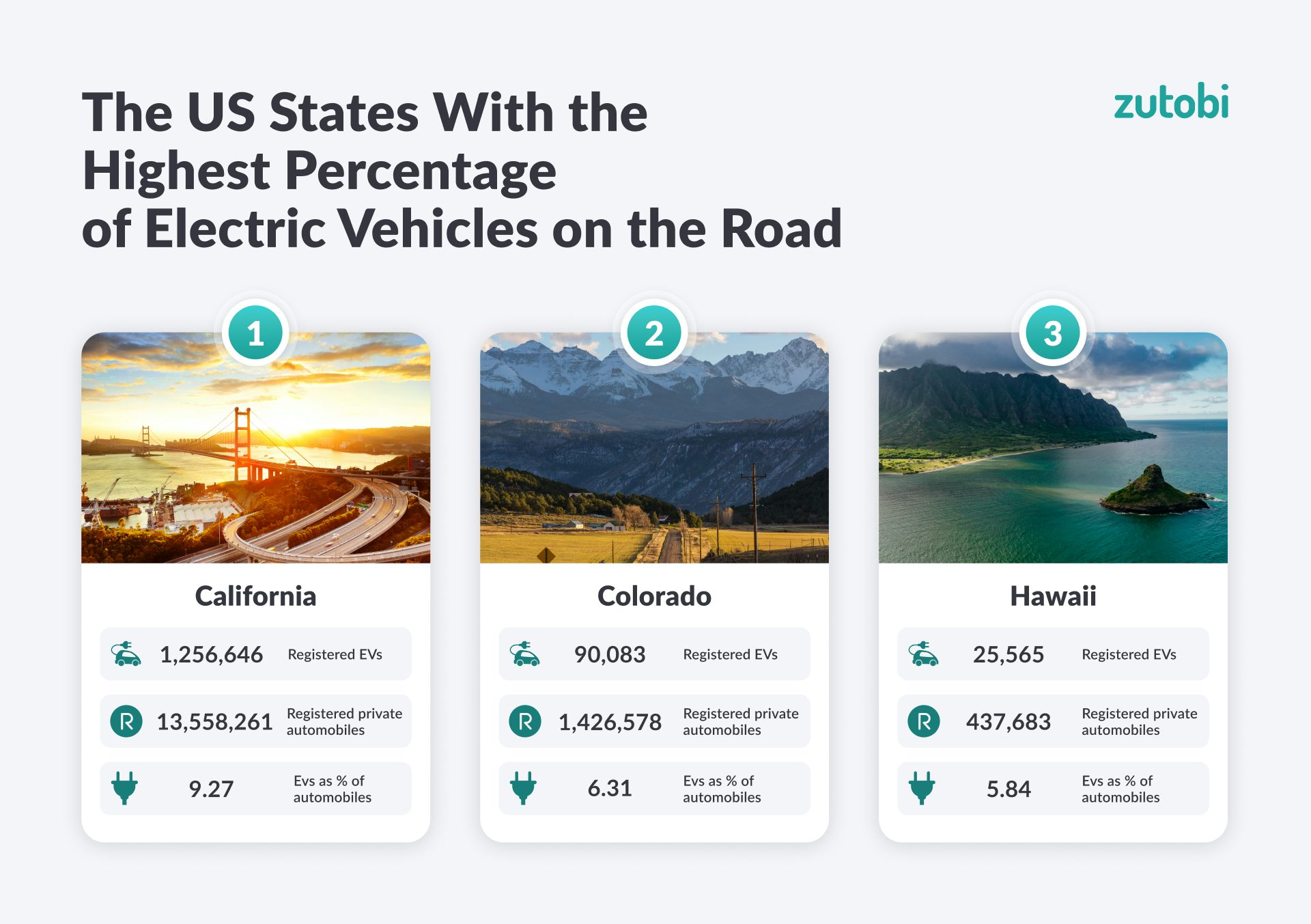
Place 1 – California
Registered EVs: 1,256,646
Registered private automobiles: 13,558,261
EVs as a percentage of total automobiles: 9.27%
California remains the leader in EV adoption in the U.S., with 9.27% of its private vehicles now electric. This impressive figure is driven by the state’s zero-emission vehicle mandate and strong environmental policies that have incentivized both individuals and businesses to transition to electric vehicles. The Advanced Clean Cars II regulation, which mandates all new cars sold by 2035 to be zero-emission, has further propelled California’s dominance in the EV market.
Place 2 – Colorado
Registered EVs: 90,083
Registered private automobiles: 1,426,578
EVs as a percentage of total automobiles: 6.31%
Colorado has also made significant strides, with over 6% of its vehicles being electric. The state’s focus on environmental sustainability, paired with attractive tax incentives for EV buyers, has helped to grow the EV market. Continued investments in charging infrastructure, including rural areas, have positioned Colorado as a leader in the transition to electric mobility.
Place 3 – Hawaii
Registered EVs: 25,565
Registered private automobiles: 437,683
EVs as a percentage of total automobiles: 5.84%
Hawaii, despite its geographical isolation, has managed to carve out a significant market share for EVs. The state’s relatively short driving distances and aggressive clean energy policies have made EVs an ideal option for residents. Government-backed programs, including incentives for purchasing electric vehicles and expanding charging stations, have supported this transition.
The US states with the lowest proportion of electric vehicles on the road
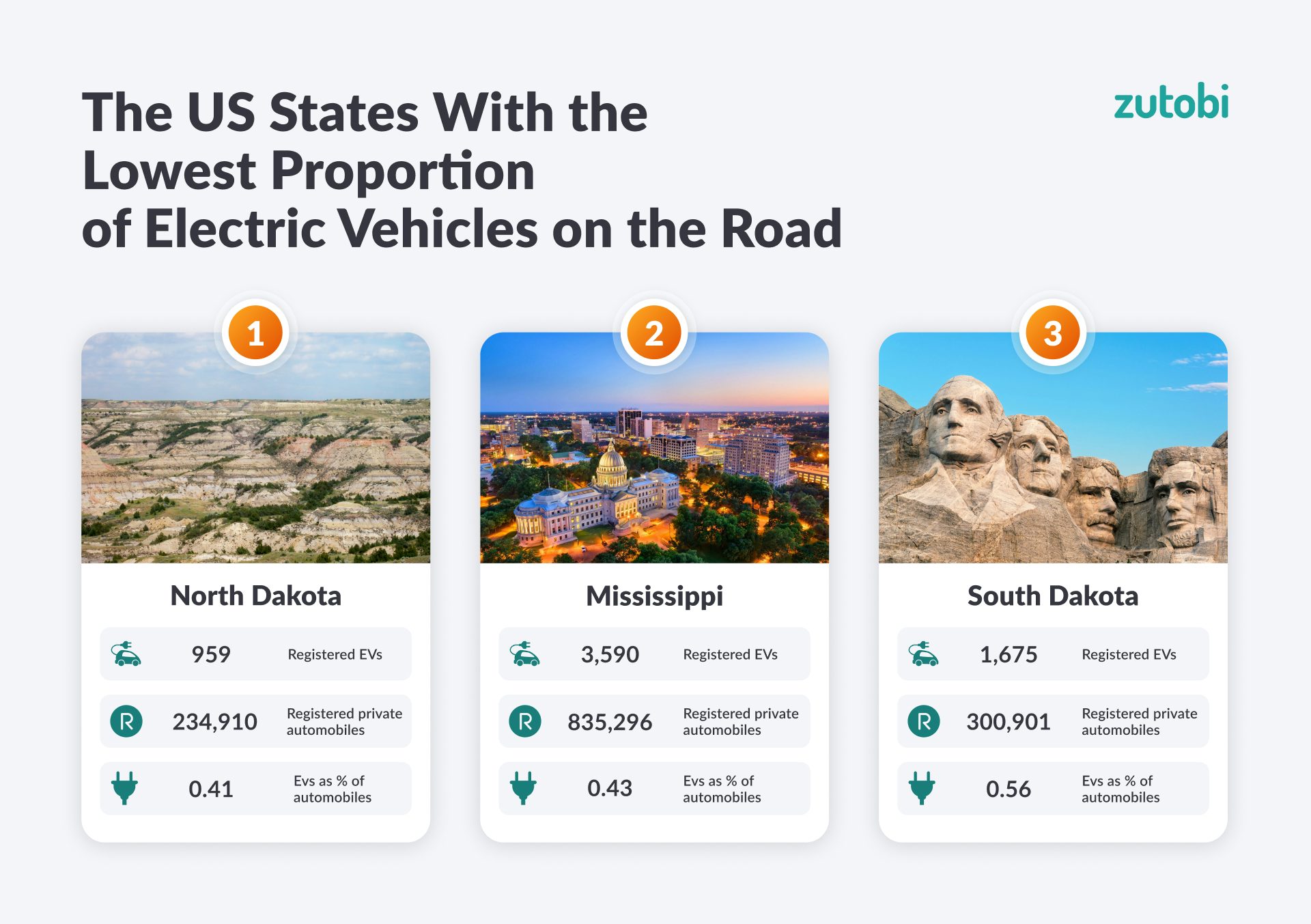
Place 1 – North Dakota
Registered EVs: 959
Registered private automobiles: 234,910
EVs as a percentage of total automobiles: 0.41%
North Dakota faces challenges in EV adoption, with only 0.41% of vehicles on the road being electric. The state’s vast rural areas and colder climate, which can negatively impact battery performance, contribute to this slow growth. While North Dakota does have a strong ratio of charging stations per EV, there is still a need for more robust policies to increase EV adoption.
Place 2 – Mississippi
Registered EVs: 3,590
Registered private automobiles: 835,296
EVs as a percentage of total automobiles: 0.43%
Mississippi has one of the lowest proportions of electric vehicles in the U.S., with just 0.43% of its vehicles being electric. The state’s rural landscape, combined with limited charging infrastructure, has hampered the growth of the EV market. Without significant investments in both infrastructure and incentives, Mississippi is likely to continue trailing behind other states in the transition to electric vehicles.
Place 3 – South Dakota
Registered EVs: 1,675
Registered private automobiles: 300,901
EVs as a percentage of total automobiles: 0.56%
South Dakota, like its northern counterpart, has a low percentage of electric vehicles, with just 0.56% of private automobiles being electric. The state’s vast rural expanse and limited EV charging infrastructure pose significant hurdles to widespread EV adoption. Although there have been investments in charging stations, more support is needed to encourage greater EV usage in the state.
States with the highest percentage of EV adoption
| № | State | Registered EVs | Registered private automobiles | Evs as % of automobiles |
|---|---|---|---|---|
| 1 | California | 1,256,646 | 13,558,261 | 9.27 |
| 2 | Colorado | 90,083 | 1,426,578 | 6.31 |
| 3 | Hawaii | 25,565 | 437,683 | 5.84 |
| 4 | New Jersey | 134,753 | 2,327,099 | 5.79 |
| 5 | Washington | 152,101 | 2,752,667 | 5.53 |
| 6 | Delaware | 8,435 | 168,037 | 5.02 |
| 7 | Oregon | 64,361 | 1,337,439 | 4.81 |
| 8 | Nevada | 47,361 | 1,008,913 | 4.69 |
| 9 | Vermont | 7,816 | 170,444 | 4.59 |
| 10 | New York | 131,250 | 2,955,805 | 4.44 |
| 11 | Dist. of Columbia | 8,066 | 188,795 | 4.27 |
| 12 | Utah | 39,998 | 948,368 | 4.22 |
| 13 | Arizona | 89,798 | 2,168,310 | 4.14 |
| 14 | Massachusetts | 73,768 | 1,879,015 | 3.93 |
| 15 | Maryland | 72,139 | 1,997,970 | 3.61 |
| 16 | Florida | 254,878 | 7,664,561 | 3.33 |
| 17 | Texas | 230,125 | 7,564,519 | 3.04 |
| 18 | Virginia | 84,936 | 2,898,548 | 2.93 |
| 19 | Connecticut | 31,557 | 1,100,313 | 2.87 |
| 20 | Georgia | 92,368 | 3,360,744 | 2.75 |
| 21 | Illinois | 99,573 | 3,726,086 | 2.67 |
| 22 | New Hampshire | 9,861 | 438,606 | 2.25 |
| 23 | Oklahoma | 22,843 | 1,024,853 | 2.23 |
| 24 | Minnesota | 37,050 | 1,685,164 | 2.20 |
| 25 | North Carolina | 70,164 | 3,231,937 | 2.17 |
| 26 | Alaska | 2,697 | 132,017 | 2.04 |
| 27 | Rhode Island | 6,396 | 322,198 | 1.99 |
| 28 | Maine | 7,377 | 371,644 | 1.98 |
| 29 | Pennsylvania | 70,154 | 3,696,871 | 1.90 |
| 30 | Michigan | 50,284 | 2,679,646 | 1.88 |
| 31 | New Mexico | 10,276 | 585,077 | 1.76 |
| 32 | Idaho | 8,501 | 553,545 | 1.54 |
| 33 | Missouri | 26,861 | 1,761,054 | 1.53 |
| 34 | Tennessee | 33,221 | 2,271,286 | 1.46 |
| 35 | Wisconsin | 24,943 | 1,707,309 | 1.46 |
| 36 | Kansas | 11,271 | 823,017 | 1.37 |
| 37 | Indiana | 26,101 | 1,991,693 | 1.31 |
| 38 | Ohio | 50,393 | 3,948,053 | 1.28 |
| 39 | Nebraska | 6,920 | 584,875 | 1.18 |
| 40 | South Carolina | 20,873 | 1,766,166 | 1.18 |
| 41 | Montana | 4,608 | 473,415 | 0.97 |
| 42 | Iowa | 9,031 | 1,055,910 | 0.86 |
| 43 | Kentucky | 11,617 | 1,449,214 | 0.80 |
| 44 | Arkansas | 7,108 | 910,969 | 0.78 |
| 45 | Alabama | 13,047 | 1,995,247 | 0.65 |
| 46 | Wyoming | 1,139 | 183,725 | 0.62 |
| 47 | West Virginia | 2,758 | 465,489 | 0.59 |
| 48 | Louisiana | 8,150 | 1,453,693 | 0.56 |
| 49 | South Dakota | 1,675 | 300,901 | 0.56 |
| 50 | Mississippi | 3,590 | 835,296 | 0.43 |
| 51 | North Dakota | 959 | 234,910 | 0.41 |
How have the number of EVs and charging stations in the US changed?
The growth in electric vehicle (EV) adoption across the U.S. has been remarkable over the past year. In 2023, there were just over 1.45 million registered EVs, but by 2024, that number skyrocketed to more than 3.1 million, representing a 114% increase in electric vehicle registrations nationwide. States like Oklahoma, Arkansas, and Michigan have seen the most significant growth, with increases of over 180%, driven by a combination of state-level incentives, expanding charging infrastructure, and growing consumer demand for cleaner transportation options.
While EV registrations have surged, the expansion of charging infrastructure has also accelerated, albeit at a slower pace. In 2023, there were around 143,771 public charging stations, and this number increased to 180,000 in 2024, representing a 25% growth in the total number of charging stations. States like Connecticut and Louisiana led the nation in this area, with increases of over 40% in their charging infrastructure.
However, as EV adoption continues to outpace the growth in charging stations, ensuring that charging infrastructure keeps up with demand will be critical. While states like Michigan and Delaware have made significant investments in charging networks, many rural and less populated areas still lag behind, presenting challenges for EV drivers in those regions.
To support this growth, federal and state programs have been implemented, such as President Biden’s goal to have 50% of new car sales be electric by 2030, and infrastructure bills that provide funding for EV charging stations nationwide. These initiatives are crucial to addressing range anxiety and making electric vehicles a viable option for all drivers, regardless of location.
States with the biggest increase in registered EVs
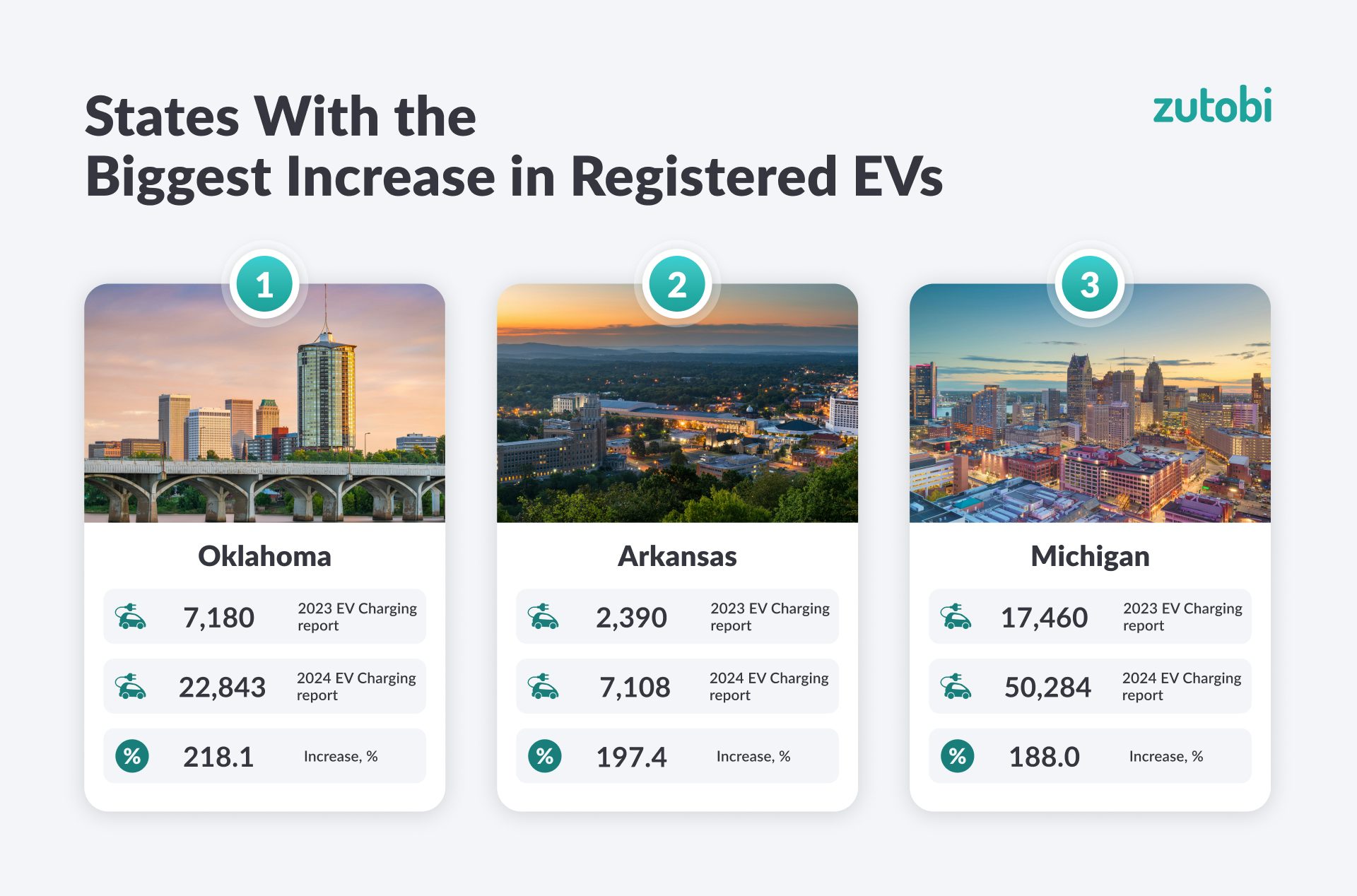
Place 1 – Oklahoma
Registered EVs in 2023: 7,180
Registered EVs in 2024: 22,843
Percentage growth: 218.1%
Oklahoma saw the largest growth in EV registrations, with a staggering 218.1% increase. This boom can be attributed to both federal and state incentives, including tax rebates for EV purchases and the expansion of charging infrastructure. Oklahoma’s success highlights how targeted policies can accelerate the transition to electric vehicles, even in states with a traditionally smaller EV market.
Place 2 – Arkansas
Registered EVs in 2023: 2,390
Registered EVs in 2024: 7,108
Percentage growth: 197.4%
Arkansas has witnessed a significant 197.4% increase in electric vehicle registrations. This growth is a result of new EV-friendly policies and the state’s expanding charging network, which has made owning an electric vehicle more feasible for its residents. Arkansas is quickly emerging as a state to watch in the evolving EV landscape.
Place 3 – Michigan
Registered EVs in 2023: 17,460
Registered EVs in 2024: 50,284
Percentage growth: 188.0%
Michigan, long known as the heart of the U.S. automotive industry, saw an impressive 188% growth in EV registrations. The state’s transition to electric vehicles is bolstered by a strong manufacturing base and significant investments in EV infrastructure, with Michigan positioning itself as a leader in the nation’s electric vehicle revolution.
States with the biggest increase in registered EVs
| № | State | Registered EVs (2023 Report) | Registered EVs (2024 Report) | Increase, % |
|---|---|---|---|---|
| 1 | Oklahoma | 7,180 | 22,843 | 218.1 |
| 2 | Arkansas | 2,390 | 7,108 | 197.4 |
| 3 | Michigan | 17,460 | 50,284 | 188.0 |
| 4 | Texas | 80,900 | 230,125 | 184.5 |
| 5 | New Jersey | 47,830 | 134,753 | 181.7 |
| 6 | Maryland | 25,630 | 72,139 | 181.5 |
| 7 | South Carolina | 7,440 | 20,873 | 180.6 |
| 8 | Delaware | 3,010 | 8,435 | 180.2 |
| 9 | Montana | 1,650 | 4,608 | 179.3 |
| 10 | North Carolina | 25,190 | 70,164 | 178.5 |
| 11 | Virginia | 30,660 | 84,936 | 177.0 |
| 12 | Kentucky | 4,220 | 11,617 | 175.3 |
| 13 | Alabama | 4,750 | 13,047 | 174.7 |
| 14 | Mississippi | 1,310 | 3,590 | 174.0 |
| 15 | Tennessee | 12,160 | 33,221 | 173.2 |
| 16 | West Virginia | 1,010 | 2,758 | 173.1 |
| 17 | Illinois | 36,520 | 99,573 | 172.7 |
| 18 | Nevada | 17,380 | 47,361 | 172.5 |
| 19 | Georgia | 34,020 | 92,368 | 171.5 |
| 20 | Wisconsin | 9,330 | 24,943 | 167.3 |
| 21 | Missouri | 10,050 | 26,861 | 167.3 |
| 22 | Florida | 95,640 | 254,878 | 166.5 |
| 23 | Pennsylvania | 26,770 | 70,154 | 162.1 |
| 24 | Louisiana | 3,180 | 8,150 | 156.3 |
| 25 | Nebraska | 2,710 | 6,920 | 155.4 |
| 26 | New York | 51,870 | 131,250 | 153.0 |
| 27 | North Dakota | 380 | 959 | 152.4 |
| 28 | Indiana | 10,360 | 26,101 | 151.9 |
| 29 | Rhode Island | 2,550 | 6,396 | 150.8 |
| 30 | Kansas | 4,500 | 11,271 | 150.5 |
| 31 | New Mexico | 4,150 | 10,276 | 147.6 |
| 32 | Minnesota | 15,000 | 37,050 | 147.0 |
| 33 | Iowa | 3,660 | 9,031 | 146.7 |
| 34 | New Hampshire | 4,000 | 9,861 | 146.5 |
| 35 | South Dakota | 680 | 1,675 | 146.3 |
| 36 | Colorado | 37,000 | 90,083 | 143.5 |
| 37 | Idaho | 3,500 | 8,501 | 142.9 |
| 38 | Utah | 16,480 | 39,998 | 142.7 |
| 39 | Maine | 3,040 | 7,377 | 142.7 |
| 40 | Massachusetts | 30,470 | 73,768 | 142.1 |
| 41 | Ohio | 21,200 | 50,393 | 137.7 |
| 42 | Connecticut | 13,350 | 31,557 | 136.4 |
| 43 | Vermont | 3,370 | 7,816 | 131.9 |
| 44 | Washington | 66,810 | 152,101 | 127.7 |
| 45 | Wyoming | 510 | 1,139 | 123.3 |
| 46 | California | 563,070 | 1,256,646 | 123.2 |
| 47 | Arizona | 40,740 | 89,798 | 120.4 |
| 48 | Dist. of Columbia | 3,700 | 8,066 | 118.0 |
| 49 | Alaska | 1,290 | 2,697 | 109.1 |
| 50 | Hawaii | 14,220 | 25,565 | 79.8 |
| 51 | Oregon | 47,157 | 64,361 | 36.5 |
States with the biggest increase in charging stations
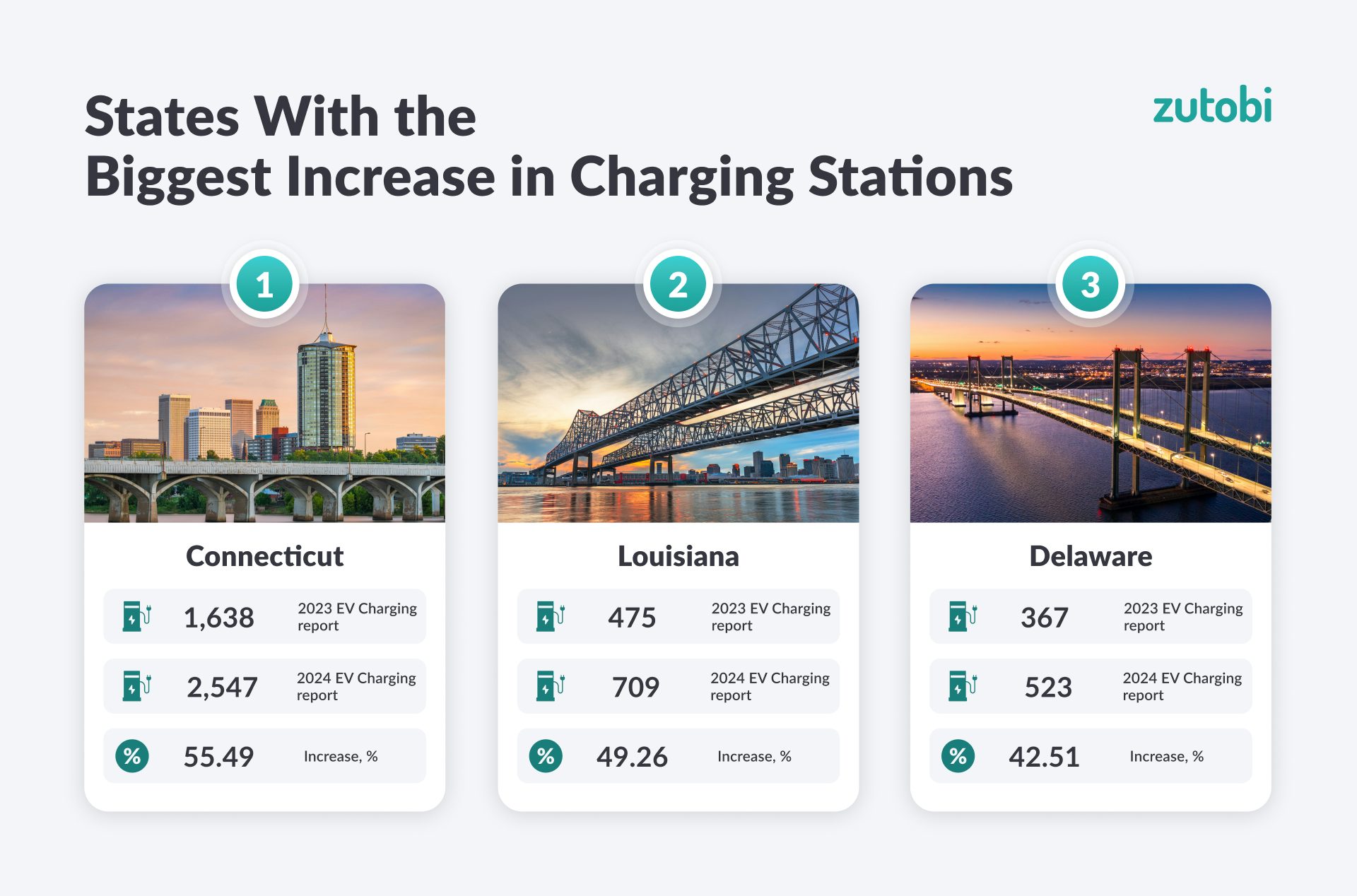
Place 1 – Connecticut
Charging points in 2023: 1,638
Charging points in 2024: 2,547
Percentage growth: 55.49%
Connecticut leads the charge with a 55.49% increase in charging stations, a testament to its aggressive push for cleaner transportation. The state’s focus on expanding infrastructure has helped make EV ownership more accessible and is setting a positive example for other states aiming to build a robust charging network.
Place 2 – Louisiana
Charging points in 2023: 475
Charging points in 2024: 709
Percentage growth: 49.26%
Louisiana saw a significant 49.26% increase in charging infrastructure over the past year. This rapid growth is part of the state’s broader efforts to reduce emissions and support the adoption of electric vehicles. Although Louisiana has been slower to adopt EVs, the expansion of its charging network is an important step forward.
Place 3 – Delaware
Charging points in 2023: 367
Charging points in 2024: 523
Percentage growth: 42.51%
Delaware’s charging infrastructure grew by 42.51%, reflecting the state’s commitment to building an EV-friendly environment. This expansion is key to supporting the increasing number of electric vehicles on Delaware’s roads, ensuring that drivers have access to reliable charging options.
States with the biggest increase in charging stations
| № | State | Total electric charging points (2023 Report) | Total electric charging points (2024 Report) | Increase, % |
|---|---|---|---|---|
| 1 | Connecticut | 1,638 | 2,547 | 55.49 |
| 2 | Louisiana | 475 | 709 | 49.26 |
| 3 | Delaware | 367 | 523 | 42.51 |
| 4 | Indiana | 1,088 | 1,533 | 40.90 |
| 5 | Arkansas | 598 | 833 | 39.30 |
| 6 | South Carolina | 987 | 1,374 | 39.21 |
| 7 | North Carolina | 3,031 | 4,204 | 38.70 |
| 8 | New Jersey | 2,694 | 3,723 | 38.20 |
| 9 | Kentucky | 616 | 849 | 37.82 |
| 10 | Montana | 252 | 347 | 37.70 |
| 11 | Texas | 6,313 | 8,637 | 36.81 |
| 12 | New Mexico | 508 | 695 | 36.81 |
| 13 | Idaho | 382 | 517 | 35.34 |
| 14 | Tennessee | 1,674 | 2,225 | 32.92 |
| 15 | Arizona | 2,638 | 3,506 | 32.90 |
| 16 | Pennsylvania | 3,247 | 4,293 | 32.21 |
| 17 | South Dakota | 176 | 232 | 31.82 |
| 18 | Minnesota | 1,517 | 1,995 | 31.51 |
| 19 | Ohio | 2,801 | 3,653 | 30.42 |
| 20 | Iowa | 659 | 855 | 29.74 |
| 21 | Alabama | 848 | 1,096 | 29.25 |
| 22 | Oregon | 2,472 | 3,190 | 29.05 |
| 23 | Wisconsin | 1,084 | 1,398 | 28.97 |
| 24 | Washington | 4,520 | 5,817 | 28.69 |
| 25 | Maryland | 3,929 | 5,022 | 27.82 |
| 26 | New Hampshire | 468 | 597 | 27.56 |
| 27 | Maine | 865 | 1,084 | 25.32 |
| 28 | Florida | 7,802 | 9,763 | 25.13 |
| 29 | Virginia | 3,651 | 4,565 | 25.03 |
| 30 | Mississippi | 441 | 551 | 24.94 |
| 31 | Oklahoma | 1,093 | 1,363 | 24.70 |
| 32 | Michigan | 2,697 | 3,352 | 24.29 |
| 33 | Nebraska | 446 | 554 | 24.22 |
| 34 | Colorado | 4,411 | 5,432 | 23.15 |
| 35 | Missouri | 2,212 | 2,703 | 22.20 |
| 36 | Massachusetts | 5,765 | 7,032 | 21.98 |
| 37 | North Dakota | 172 | 209 | 21.51 |
| 38 | Georgia | 4,121 | 4,994 | 21.18 |
| 39 | Nevada | 1,663 | 1,987 | 19.48 |
| 40 | Dist. of Columbia | 970 | 1,158 | 19.38 |
| 41 | Wyoming | 213 | 252 | 18.31 |
| 42 | Utah | 1,857 | 2,185 | 17.66 |
| 43 | New York | 9,539 | 11,114 | 16.51 |
| 44 | West Virginia | 386 | 446 | 15.54 |
| 45 | Kansas | 1,047 | 1,196 | 14.23 |
| 46 | California | 43,400 | 49,433 | 13.90 |
| 47 | Vermont | 896 | 978 | 9.15 |
| 48 | Alaska | 115 | 124 | 7.83 |
| 49 | Illinois | 3,315 | 3,510 | 5.88 |
| 50 | Rhode Island | 772 | 817 | 5.83 |
| 51 | Hawaii | 940 | 860 | -8.51 |
Methodology
The number of charging outlets in each state was sourced from the Alternative Fuels Data Center’s Alternative Fueling Station Count by State, taking the number of electric EVSE ports in each state.
The number of electric vehicles in each state was sourced from the Alternative Fuels Data Center’s Electric Vehicle Registrations by State data and refers to the number of registered electric vehicles as of December 31, 2023.The number of vehicles registered in each state was sourced from the Federal Highway Administration’s Highway Statistics and refers to the total number of private and commercial automobiles including taxicabs).
Previous reports
The 2022 EV Charging Station Report
The 2023 EV Charging Station Report
Who is behind this study?
Zutobi is an online driver’s education company with the goal to make the roads a safer place. Instead of just helping students prepare for the permit test, our top priority is to teach about driving safety practices and driver safety to create better, and safer, drivers.

550+ exam-like questions
All you need to ace your test
Perfect for first-timers, renewals and senior citizens
Recommended articles
Ace your DMV test, guaranteed
Want to Be the Top School in Your Area?
- Simple & automated admin
- More time for teaching
- #1 learning materials for students


